- Share
Labor Market Rigidity, Unemployment, and the Great Recession
The views authors express in Economic Commentary are theirs and not necessarily those of the Federal Reserve Bank of Cleveland or the Board of Governors of the Federal Reserve System. The series editor is Tasia Hane. This paper and its data are subject to revision; please visit clevelandfed.org for updates.
Countries with very flexible institutions and labor market polices, like the U.S., experienced substantial increases in unemployment over the course of the Great Recession, while countries with relatively rigid institutions and strict labor market policies, such as France, fared better. However, this better short-term performance comes with a tradeoff: evidence suggests that flexible labor markets keep unemployment lower in the long run.
The recent recession that hit the global economy resulted in substantial contractions in GDP among major industrialized countries, but their labor market outcomes varied significantly. For example, the U.S. and France experienced similar declines in GDP during the recession. While unemployment in the U.S. shot up about 5 percentage points over that period, France saw an increase of only about 1.5 percentage points. Looking over the last 25 years, however, the average unemployment rate is much lower in the U.S. than in France (5.9 percent versus 9.6 percent). What explains these differences in labor market outcomes?
We argue that some of this divergence is due to differences in labor market institutions and the policies that regulate labor market interactions. Labor markets with very flexible institutions and policies, like the U.S., experienced substantial increases in unemployment over the course of the recession. Meanwhile, countries with relatively rigid institutions and strict labor market policies, such as large continental European countries, fared better. However, this smoother short-term performance comes with a tradeoff; evidence suggests that flexible labor markets manage to keep unemployment lower in the long run.
Labor Market Rigidity and Unemployment: Theory
The unemployment rate is the main indicator of the labor market’s health, and economic theory provides an intuitive framework for understanding the forces that determine its level: At any time, there are flows into and out of unemployment, which we call job-finding and -separation rates, respectively (for more evidence on how these flow rates map into long-run unemployment rates, see Tasci and Zaman 2010). By affecting these flow rates, labor-market institutions and policies influence both short- and long-term unemployment rates. In every labor market, workers and firms are regulated by institutions and policies that affect these flow rates, such as minimum wages, unemployment insurance, severance pay, advance notice, labor taxes, and so on. The observed unemployment rate is affected by all the incentives and disincentives implied by these arrangements.
Consider unemployment insurance, which cushions workers against unemployment risk by providing some income if they lose their job. On the one hand, this is much-needed financial assistance during a jobless spell. On the other, it may also give unemployed workers an incentive to turn down job offers that they would otherwise find acceptable, thereby reducing the job-finding rate. As a result, all else equal a higher level of unemployment compensation will increase an economy’s long-run unemployment rate.
Similarly, employment-protection measures might provide a disincentive to create jobs. For instance, continental European countries have very strict laws against firing employees and hiring temporary workers. Conceivably, employers in those countries would have less flexibility to adjust their workforces in the face of a recession. A direct effect might be a muted increase in the separation rate. Although this might mitigate an increase in the unemployment rate during bad times, firms that anticipate the firing restriction might hesitate to hire in the first place, even in good times; this behavior would increase unemployment by lowering hiring (job-finding) rates.
Another example—one that gets a lot of attention—is taxation of labor income. Some researchers think that by effectively reducing the return from market work, labor-income taxes distort workers’ behavior. Most continental European countries also have high labor-income taxes.
To simplify the discussion going forward, we divide countries, somewhat arbitrarily, into two groups according to how rigid their labor markets are. We call labor markets that have stricter requirements governing employment relationships rigid, and labor markets with more lenient requirements flexible.
The Organization for Economic Cooperation and Development (OECD) publishes an “Overall Strictness of Employment Protection” index that allows us to categorize countries as rigid or flexible. The index provides a measure of the general strictness of the labor market in a country with respect to the processes and costs involved when firing workers or hiring temporary employees. The U.S. has maintained the same index value, 0.21, for the entirety of the period for which the index is available. European countries tend to have a much higher index value, with 2.5 being the average value over that period for the EU-15 countries (15 countries that made up the European Union before May 2004).
Economic theory suggests that rigid labor markets, all else equal, will have higher unemployment rates and lower rates of churning. However, labor market rigidities might dampen the fluctuations in the unemployment rate in the short run, since workers and firms in rigid markets will have a harder time adjusting to rapidly changing economic conditions, especially around the turning points of the business cycle. We will provide some evidence in support of these arguments by looking at data from some OECD countries during the last recession and over a longer period.
Labor-Market Rigidity and Unemployment during the Great Recession
As we noted above, the recent recession translated into exceptionally bad performance in world output. According to the International Monetary Fund, after growing at a rate of 4.2 percent every year between 2000 and 2007, world output rose only 2.8 percent in 2008 and contracted by 0.5 percent in 2009. This might have been the first time since World War II that the world economy actually shrank.
Looking at the sample of countries in figure 1, we see that similar-sized GDP shocks yielded a wide range of unemployment responses. Although Italy and Greece experienced similar-sized GDP shocks, Italy’s unemployment rate ticked up only slightly, whereas Greece’s rose more than 5 percentage points. Germany is unusual in that its 7 percent decline in GDP was accompanied by a decrease in its unemployment rate!
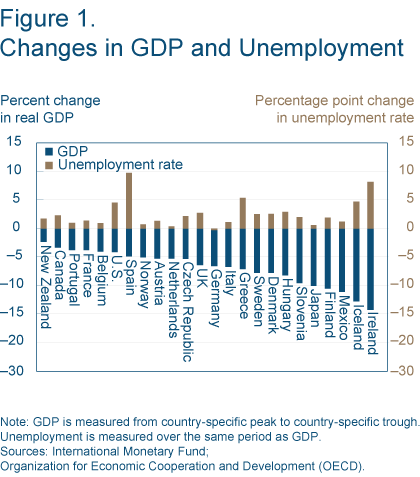
Note: GDP is measured from the country-specific trough. Unemployment is measured over the same period as GDP.
Sources: International Monetary Fund; Organization for Economic Cooperation and Development (OECD).
It’s impossible to tell from the unemployment rate alone, however, what else might be happening in the labor market to explain such data. For example, Germany’s unemployment rate declined, but those who are employed might be working less. That response would not be captured explicitly in the unemployment rate. In fact, when we look at the relevant data, we see that the length of the average work week in Germany actually plummeted throughout the recession.
So far, we have assumed that labor markets respond to aggregate economic activity, with higher unemployment rates following contractions in real output. But all economies might not respond to aggregate conditions in the same way. Since rigid labor markets might have responded differently to the contraction in output than more flexible labor markets during the Great Recession, we first plot the change in countries’ unemployment rates and their level of overall strictness (using the OECD’s indicator) and see how the relationship plays out (figure 2).
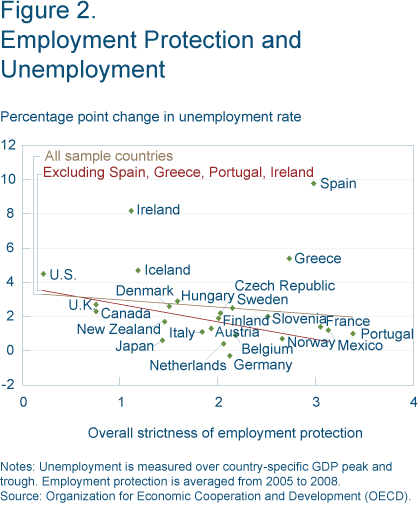
Note: Unemployment is measured over country-specific GDP peak and trough. Employment protection is averaged from 2005 to 2008.
Source: Organization for Economic Cooperation and Development (OECD).
Our sample countries vary widely in the strictness of their employment protection, taking values between 0.2 and 3.4 (the OECD average is 1.9). The United States has the lowest employment protection score of the countries in the sample. Correspondingly, its unemployment rate response is one of the strongest on the chart. The trend line suggests a somewhat negative relationship: As employment protection increases, the unemployment rate response becomes more muted. This relationship is even stronger if we exclude Spain, Ireland, Greece, and Portugal, which all had deep fiscal crises on top of the recession. Nevertheless, this relationship ignores the variance in the severity of the recession across countries.
To understand how the severity of the recession interacted with the degree of employment protection, we plot the change in the unemployment rate against the decline in GDP and calculate a trend line for each of the two types of countries, rigid and flexible (figure 3). The flexible countries exhibit labor markets whose responses vary with the depth of the GDP decline: The more severe contractions are associated with larger increases in the observed unemployment rate. In the rigid countries, when GDP reductions increase in severity, the labor market does not re-calibrate accordingly
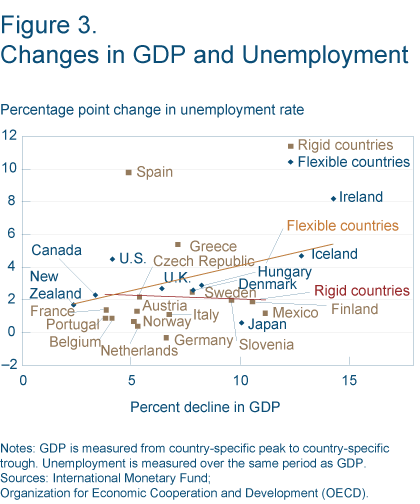
Note: Unemployment is measured over country-specific GDP peak and to country-specific trough. Unemployment is measured over the same period as GDP.
Source: International Monetary Fund; Organization for Economic Cooperation and Development (OECD).
One should interpret these results cautiously because a small sample for a particular episode does not necessarily generalize to other episodes. Nevertheless, this casual correlation suggests that, in countries with relatively strict employment protection, increasingly large declines in GDP fail to yield additional increases in the unemployment rate.
Labor Market Rigidity and Unemployment: Long-Term Evidence
Do we see higher unemployment rates in countries with more rigid labor markets over the long run? Coming into the 1980 recession, the EU-15 countries actually maintained an unemployment rate lower than that of the U.S. However, coming out of the recession, unemployment in those countries remained elevated, whereas the U.S. experienced a cyclical decline and return to trend.
Since then, EU-15 unemployment has been trending around 3 percentage points higher than the U.S. (see figure 4). Economists attribute some of this divergence to the so-called “skill-biased technical changes” that occurred throughout the 1980s, along with labor-market rigidities (Blanchard, 2006; Ljungqvist and Sargent, 2008). Skill-biased technical change is a shift in production technology that favors skilled over unskilled labor by increasing its relative productivity and, therefore, its relative demand. In the face of skill-biased technical change, recently displaced workers face the prospect of large human capital losses. Because generous unemployment benefits tend to increase the duration of unemployment spells, they may exacerbate human capital losses.
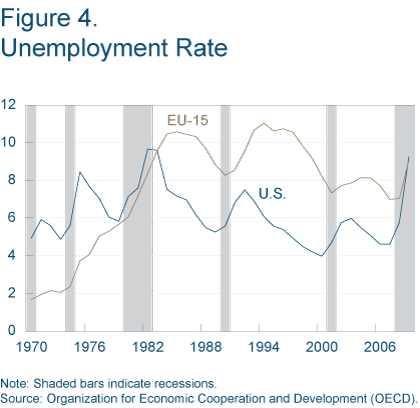
Note: Shaded bars indicate recessions.
Source: Organization for Economic Cooperation and Development (OECD).
One artifact of a rigid labor market is the prevalence of long-term unemployment, which contributes to an elevated trend unemployment rate in the long run. The U.S. and EU-15 labor markets have drastically different shares of long-term unemployed workers (figure 5). The share rose steadily throughout the 1970s and 1980s in the EU and has remained elevated. While the share has been trending up slightly in the U.S., the majority of the unemployed are short term.
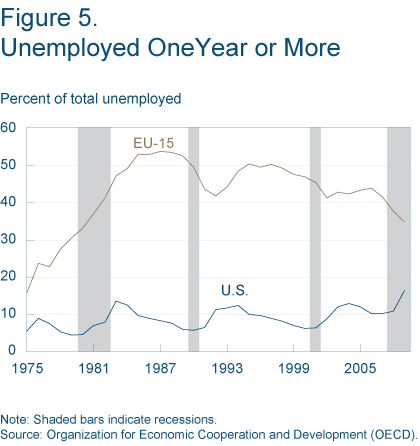
Note: Shaded bars indicate recessions.
Source: Organization for Economic Cooperation and Development (OECD).
For workers, skill-biased technical change might mean that the rate of skills depreciation accelerates during periods of unemployment, so long-term unemployment is particularly damaging. Increasingly, rapid technological change is difficult for unemployed workers in any type of labor market. Skill-based technical change, combined with a rigid labor market, creates a particularly precarious situation for the long-term unemployed. For instance, generous unemployment benefits might inadvertently enable workers to stay unemployed longer than they would otherwise have done. But as these displaced workers stay unemployed longer, they lose more human capital and valuable skills because of technical change. This loss in turn makes them less desirable to potential employers.
In the past decade, some EU countries have instituted labor-market reforms (partly reflected in their declining values in the employment protection index), which may help to account for some of the decline in their unemployment rates. For example, Portugal’s initial employment protection rating was 4.15, but it has gradually decreased to 3.15. Italy had an initial reading in 1985 of 3.57, but currently it is 1.89. Finland and Greece also have lower employment protection rankings now than they did in the mid-1980s. At the same time, some countries, like the UK, Ireland, and France, increased their protection as measured by the index.
Conclusion
Movements of workers in and out of jobs, which we can call job finding and separation rates, determine to some extent the path of the unemployment rate in any given economy. By affecting these rates over short and long time horizons, institutions play a nontrivial role in the labor market. In the short term, rigid labor markets may help prevent spikes in the unemployment rate, but they tend to keep trend unemployment higher than flexible labor markets in the long term. Therefore, when examining labor-market performance, the effect of these institutions on both long- and short-term dynamics should be taken into account.
References
- “European Unemployment: The Evolution of Facts and Ideas,” by Olivier Blanchard. Center for Economic Policy Research, Economic Policy, vol. 21, no. 45 (January 2006).
- “Two Questions about European Unemployment,” by Lars Ljungqvist and Thomas J. Sargent. Econometrica, vol. 76, no. 1 (January 2008).
- “Long-Term Changes in Labor Supply and Taxes: Evidence from OECD Countries, 1956-2004,” by Lee E. Ohanian, Richard Rogerson, and Andrea Raffo. 2008. Journal of Monetary Economics, vol. 55 (2008).
- “Unemployment after the Recession: A New Natural Rate?” by Murat Tasci and Saeed Zaman. Federal Reserve Bank of Cleveland, Economic Commentary, no. 2010-11 (September 2010).
Suggested Citation
Tasci, Murat, and Mary Zenker. 2011. “Labor Market Rigidity, Unemployment, and the Great Recession.” Federal Reserve Bank of Cleveland, Economic Commentary 2011-11. https://doi.org/10.26509/frbc-ec-201111
This work by Federal Reserve Bank of Cleveland is licensed under Creative Commons Attribution-NonCommercial 4.0 International




